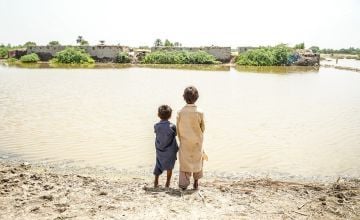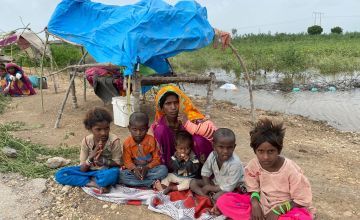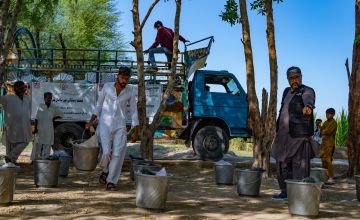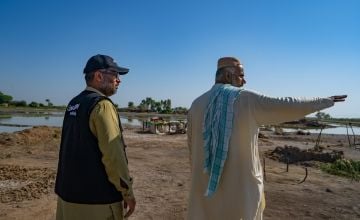
Knowledge Hub
The Pakistan floods, explained: 5 things you need to know

Since June 2022, flooding in Pakistan has impacted 15% of the country’s population. Record-breaking monsoon rains left one-third of its land underwater. Rains in June alone were 67% above normal levels.
Things worsened as monsoons intensified. On August 27, rainfall in Pakistan was been nearly three times the national average over the last 30 years. This was also just one of the current effects of the climate crisis in the country. With the next monsoon season fast approaching, here’s what you need to know.
1. These were the heaviest rains in Pakistan in over a century
The World Bank’s Ali Tauqeer Sheikh, an expert on climate in Pakistan, told NPR that, “in the recorded history [of the area] that we have since 1918, we have never had this much rain.”
While monsoon season is a normal part of summers in Pakistan (along with Bangladesh and much of Southeast Asia), the intensity of last year’s storms caused a devastatingly outsized impact.
Last year's flooding in Pakistan:
- Affected 33 million people (15% of the country’s population, close to the size of Canada's population).
- Displaced 7.9 million people.
- Destroyed 4.4 million acres of food crops.
- Killed over 1,600 people — including 348 children.
- Injured over 12,800 people.
- Destroyed or damaged nearly 1 million homes, 269 bridges, and over 67,000 km of roads.
- 75,000 km area was under water for 6-7 months.
“Many have lost their homes and livelihoods,” says Concern’s acting Country Director for Pakistan, Sherzada Khan, who notes that the provinces of Balochistan, Sindh, and Punjab have been hit especially hard. The province of Sindh alone has seen 4.5 million people displaced, roughly equivalent to the entire population of Louisiana, or the cities of Los Angeles and Boston combined.
“The magnitude and scale of the destruction to the country cannot be underestimated,” Khan adds. “We are responding to a very serious humanitarian situation with a significantly high number of deaths and the numbers continuing to rise every hour.”
2. Nearly half of the country was in a state of emergency

It’s important to note the scope and size of these floods, as well as their connection to the climate crisis.
Pakistani senator and Climate Change Minister Sherry Rehman called the monsoon floods “a serious climate catastrophe.” What’s more, 72 of the country’s 160 districts were declared “calamity-hit” by the government, which also declared a national emergency.
Some regions have been hit harder than others.
In Sindh province, rainfall has exceeded the 30-year average by 5.7 times. Balochistan province has seen more than five times its 30-year average rainfall in the last three months. This is especially worrisome, as Pakistan’s National Disaster Management Authority (NDMA) reports that Balochistan is not usually affected by monsoon season.
3. Pakistan is on the frontline of the climate crisis
On the frontlines of the climate crisis, Pakistan is home to some of the most affected people and areas. Despite its capital city housing nearly 15 million people, more than 60% of Pakistanis live in rural areas, depending on the land for their food and livelihoods. Around 90% of agricultural land in the areas where Concern works in Pakistan was submerged.
The UN estimated approximately 2 million acres of crops and orchards were damaged or destroyed, with over half of those acres (1.54 million) located in Sindh province. The final numbers came in at 4.4 million acres.
An additional 304,000 acres in Balochistan and 178,000 acres in Punjab were also been affected. This could potentially increase Pakistan’s silent food crisis. According to the 2021 Global Hunger Index, it ranks 92nd out of 116 countries for indicators of hunger, including over 20% of the population undernourished. The country is also facing rising food prices.

4. The monsoons are just one of the current crises in Pakistan
As reports noted, the monsoons are just one of the sources of flooding in Pakistan. Minister Rehman notes that Pakistan has the highest number of glaciers outside of the polar region. Warming in the Himalayas, however, has led to many of these glaciers melting, leaving to flash floods.
“Instead of keeping their majesty and preserving them for posterity and nature,” Rehman says, “we are seeing them melt.”
On the flip side, Pakistan has also seen some of the highest temperatures on record in recent years. In July 2021, temperatures in the Sindh city of Jacobabad (which New York Times author Fatima Bhutto called the hottest city in Asia, if not the world) exceeded 126º F, “too severe for human tolerance.”
The World Bank calls the capital city of Karachi (also in Sindh) another “climate hot spot,” estimating an increase in climate events - and their destruction - in the coming years.
5. The current crisis is not just about climate change
That all said, some of the issues relating to the high impact of these monsoon floods go beyond the climate crisis.
The floods, as Concern’s Regional Director for Asia, Lucia Ennis, explains, “came at a time when Pakistan was already trying to cope with one of the worst economic crises in its history, with high inflation and food and fuel prices rocketing.” The country is also still facing the Covid-19 pandemic, which means that displacement caused by the floods could lead to a spike in cases.
Abid Qaiyum Suleri, Executive Director of the Sustainable Development Policy Institute and member of Pakistan’s Climate Change Council, added that the country has suffered a lack of disaster risk reduction following previous disasters.
“Pakistan saw similar flooding and devastation in 2010 that killed nearly 2,000 people,” he said in an interview with the AP. “But the government didn’t implement plans to prevent future flooding by preventing construction and homes in flood prone areas and river beds.”
Delivering humanitarian aid in Pakistan has also historically been a challenge. When an emergency hits, it can be difficult to know which organisations in the country are legitimate and able to use funding to help those who need it most. Meanwhile, time is of the essence in an emergency response. Grants can often take months (if not years) to be delivered.

Concern's response

Having worked in the country for over 20 years, Concern’s teams responded in the provinces of Balochistan, Sindh, and Punjab. Our relief packages included cash transfers that enabled extremely-vulnerable families to buy the essentials that they need most and hygiene and dignity kits.
Overall, we supported around 1,500,000 individuals through:
-
Multi-purpose cash assistance,
-
Temporary Shelters,
-
Hygiene items and kitchen sets,
-
WASH (latrines, water provision, rehab of water schemes, hygiene promotion),
-
Health consultations through mobile clinics,
-
Livelihoods support.

This was also a chance for one of Concern’s long-term projects in Pakistan to be put to the test: In response to the difficulty of funding emergency response programs in the country, RAPID (Responding to Pakistan’s Internally Displaced) was developed in 2009 to assist the most vulnerable people in the aftermath of any natural or man-made disaster in Pakistan.
With an established network of organisations, the programme allows for funds to get where they need to go most, often in as little as two days.
RAPID works closely with disaster management authorities, local NGOs, and communities to give smart and secure sub-grants to national and international organizations, often within an average of two weeks. Some grants have been processed in just two days. This makes RAPID the most easily-accessible fund for local partners in Pakistan.
Other ways to help
Donate now
Give a one-off, or a monthly, donation today.
Join an event
From mountain trekking to marathon running, join us for one of our many exciting outdoor events!
Buy a gift
With an extensive range of alternative gifts, we have something to suit everybody.
Leave a gift in your will
Leave the world a better place with a life-changing legacy.
Become a corporate supporter
We partner with a range of organisations that share our passion and the results have been fantastic.
Create your own fundraising event
Raise money for Concern by organising your own charity fundraising event.





